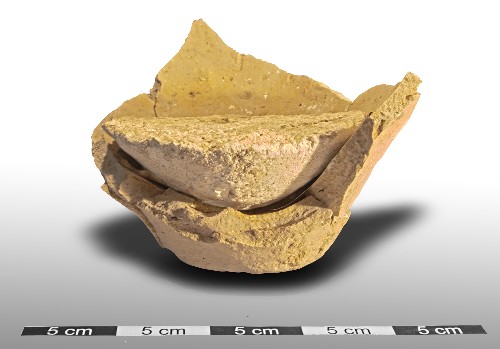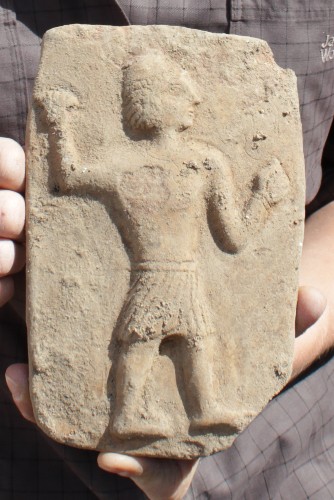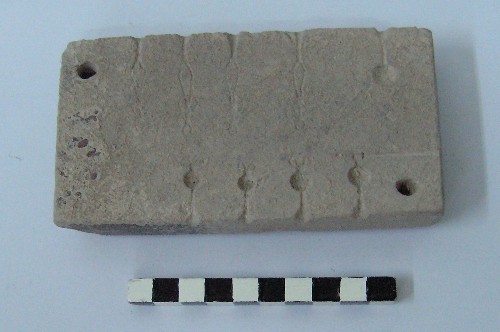2011 - Campaign Spring
In Area I three different parts were excavated this year. The first one is situated in the centre of Area I. It is that part in the East which was not affected by the land slide that happened in the Late Bronze Age (14th century B.C.) and where architectural features have been remained. Last summer, the upper level of the Middle Bronze Age I/Early Bronze Age IV was reached. During the spring campaign, two levels of scattered phases from those eras were excavated. The remains consist of a lot of pits, fireplaces, occupational floors and some faint stonewalls. The finds show that this area was used for living activities like cooking, grinding and storage. Below the scattered phases a new occupational layer from the Early Bronze Age (EB III?) with house structures was reached.
The second part which was excavated in Area I was located at the western slope. During the last campaigns a straight canal was found running from the last Late Bronze Age level straight through the slope cutting city wall and a glacis which were probably built in the Early Bronze Age. During the spring campaign 2011, the relation between the wall with the glacis and the canal was further examined. The course of the canal could be ascertained and its end was reached.

Industry vessel
The third part of excavation in Area I was the extension of the area which was opened in 2007. In the southern part a large Late Bronze Age building with a pebble paved courtyard was excavated in 2010 but the eastern part of the architecture could not be cleared during that campaign. The excavations of the 2011 campaign showed that the courtyard was limited to the north by a thick wall. However, only the negative of this wall could be found shown by the limitation of the courtyard pavement as well as the ditch for the foundation. The original wall was completely robbed out by the Iron Age I settlers during their building activities.
In the northern part of that area below the Iron Age I occupation a stratum of the Late Bronze Age was reached. The stone foundations of several rooms could be found. Only in small parts remains of mud brick walls with lime plaster were uncovered. It needs further excavations to clear up the whole layout of this occupation layer. They will be carried in summer 2011. The most interesting find in this area is a votive plate made of ceramic with the depiction of a god or warrior.

god or warrior?
Area II
The aim of the excavations in Area II was the investigation of the occupation from the Umayyad to the Hellenistic period.
The Umayyad period is characterized by a house in the western part of the area and several re-occupations of houses of the Byzantine period. It could be shown, that the courtyard with a large entrance was not built in the Byzantine but in the Umayyad period. The architecture of the Umayyad period is recognizable by a special building technique of binder and stretcher. The buildings are founded very deeply and cut into the Hellenistic level.
The earliest building phase of the Byzantine period could be cleared. It consisted of a house with two rooms. This building was extended by a large courtyard to the north and a vestibule to the east.
After the destruction of this house, new rooms were built against the remaining walls and a new concept of layout was created.
In the eastern part of Area II the pre-Byzantine occupation was further investigated. The foundations of a room in three different stratigraphical building stages could be proven.
In various parts of Area II, further remains of this phase, which can be dated to the Roman period were excavated.
The course of the foundations of a very thick wall which was dated to the Hellenistic period could be cleared in the western part of the area. It is running into the baulk so that its end cannot be excavated.
The most important find in Area II is a casting mould for beads. It was found in the layer of the Roman period. This proves the assumption of metal processing on Tall Zar‘a.

casting mould for beads
Acknowledgements
Our thanks go to all of the very generous institutions and individuals who support our work: the Department of Antiquities of Jordan for issuing the permits for our work and also the German Protestant Church, the Friends of the BAI Wuppertal, the GPIA Jerusalem/Amman and the Gerda-Henkel-Stiftung, Düsseldorf, for their long-term and consistent facilitation of our very successful work in the “Gadara Region Project”.
Last updated: 2011
|
CURRENT NOTE (2017) The results of the excavation campaigns from 2003 to 2011 are represented in detail in the final publication. |
|
Project Partners |
|
Biblical Archaeological Institute Wuppertal (BAI) |
|
Patronage |
|
His Royal Highness Prince El Hassan bin Talal took up the patronage of this project as a representative of the royal house. |
Friends and Donors |
|
Cooperations |
|
We cooperate closely with many universities, institutes and companies.  |

 print version
print version
